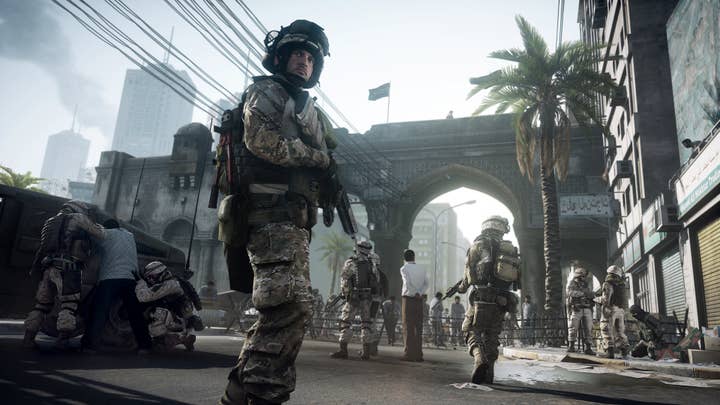Tech Focus: The Next-Gen Challenge
Will next-gen consoles really produce Avatar quality visuals? Digital Foundry investigates
Looking forward, we should also expect to see the raw power available for far more complex 3D modelling - a revelatory increase, perhaps. At the moment, even high-end PC games are mostly operating with relatively low levels of geometry compared to the raw potential of modern GPUs - models are produced to console standards and in many cases the PC only benefits through less aggressive handling of LODs and in some cases, DX11-powered tessellation - which dynamically increases mesh complexity the closer the object is to the camera. In truth, current gen PCs have an embarrassment of untapped power in terms of geometry processing and have possessed it for years - to a certain extent it's the reason that PC specific technologies such as NVIDIA 3D Vision and AMD EyeFinity came into being - to utilise this latent, untapped power.
In other areas, a CPU bump also opens up so many more opportunities in terms of animation, physics and AI. Carmack talks about the "delta" that makes people care about the next-gen - it's elements like these when integrated with the improved visuals that produce a proper revolution in the gameplay experience, and it's my contention that there's still a long way to go in these regards before we're anything close to a video games equivalent to the Avatar experience.
We are already seeing developers making the transition between generations via exploratory work with DirectX 11 - the programming foundation of next-gen console graphics cores
Already we are seeing some hints on how next-gen visionaries are planning for the future, albeit mostly through experimentation in the visual area. In the here and now we are already seeing developers making the transition between generations via exploratory work with DirectX 11 - the programming foundation we expect to see form the basis of the GPUs that will be used in the next-gen consoles. Crytek's work on upgrading Crysis 2 gives a small indication of the kind of effect that tessellation can make, also boasting significantly improved textures and effects like displacement mapping, parallax occlusion mapping, improved shadows, water and depth-of-field. While it can't be described as a revelatory improvement, the quality of the work is remarkable.


Codemasters' EGO engine has also received extensive DX11 upgrades, radically improving the look of DiRT 3 in particular: while geometry is still fairly limited, running the game at 1080p60 with all DX11 enhancements active provides a vastly improved experience over the standard console builds: not quite what we would expect from next-gen quality as an overall package but a marked improvement nonetheless. At the very least it gives some hints as to how early next-gen titles may look - based on the rendering paradigms of today but beefed up with some seriously impressive new hardware and effects work.
We also see DICE making moves to address DX11 with its hugely anticipated Battlefield 3, which features a raft of technology choices we will see adopted on next-gen consoles. DX11 compute shaders power the stunning new tile-based deferred lighting system as well as the multi-sample anti-aliasing implementation, while tessellation is used to give a new dimension to the landscapes - there's a richness to Battlefield 3's environments on PC that the console builds clearly don't match. Post-processing effects should also benefit from the additional precision PC hardware offers, on top of the usual resolution and frame-rate benefits a suitably equipped computer gives players by default.
But are these enough to actually make people care in the way that Carmack talks about? With these technological improvements in the hands of today's game engineers, there's no question about it. Consider the absolute state-of-the-art of FPS titles on the last gen PlayStation 2 and Xbox: Criterion's genre-defining Black. Its gaming DNA can be traced directly to Battlefield 3, but the increase in fidelity in all aspects of the experience from the visuals to the physics simulation to the sheer immersion level is incredible. The technologies being developed now in the motion picture technology suggest that what DICE is doing with BF3 really is just the beginning: the more processing power available, the grander the scale of the simulation.
In addition to that, Epic's Unreal Engine Samaritan demo gives us tantalising hints of how characters can "grow" with next-gen technology. In the demo we see people that look more realistic, that the audience can empathise more closely with. Just the tiniest details - skin shaders on the main character, for example - have been beautifully rendered, while interaction with the environments and the overall effects work help produce a world that is clearly a step beyond what we're experiencing in current generation titles. It's all in real-time and it's glorious - it's no Avatar but it is a realistic, mouth-watering taste of the future of gaming.
In the here and now, with the current generation console hardware, the state-of-the-art is all about ever more ingenious iterations of existing rendering techniques, cramming more effects, higher levels of detail and ever-more impressive artwork into mere milliseconds of CPU/GPU time. Gears of War 3 joins the ranks of illustrious titles such as Killzone 3, Crysis 2 and God of War III in pushing console hardware to its limits. They are absolutely phenomenal games - a clear step beyond their contemporaries - but just like Criterion's Black back in 2005, they are very much games of their generation.
How long this era will continue remains to be seen, but I strongly suspect the platform holders will be calling time during the keynotes of E3 2012...
